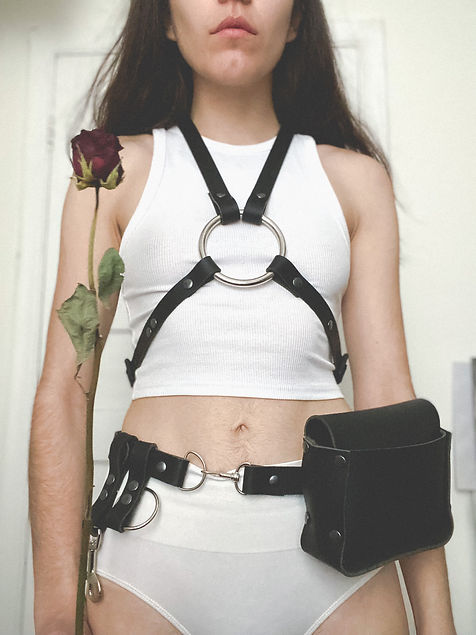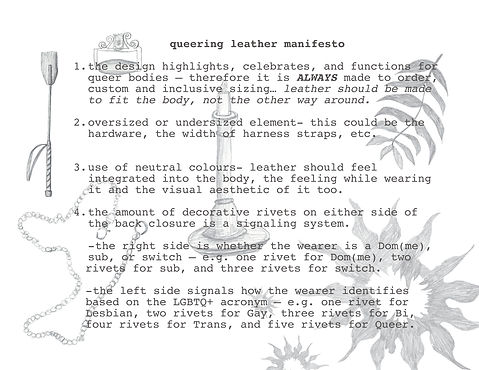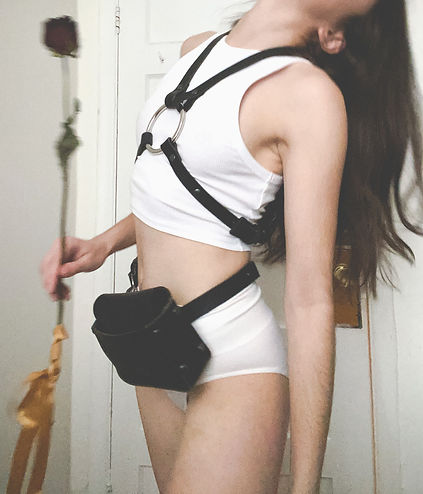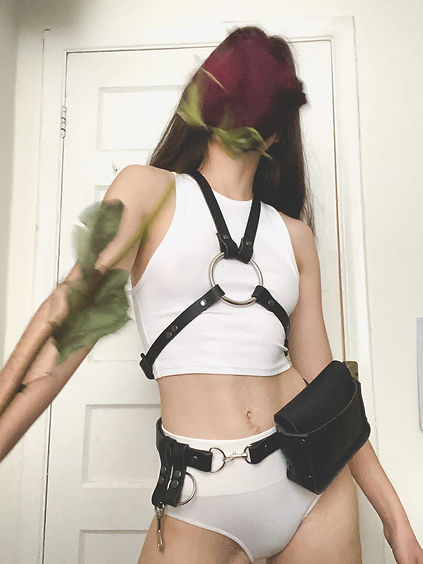affect &
leatherwork
My Queering Leather manifesto and implementing the manifesto into a harness allowed me to further engage with the topic of queer kink leatherwork. As I explored affect and leatherwork in an earlier assignment in this course I was able to explore how queer identity is embodied and expressed outward while also affecting the wearer by allowing them to feel affirmed in their queer and kink identities through wearing leatherwork. Although the realization and affirmation that queer leatherwork is different than its heteronormative counterpart, the question arose - “how does queer leatherwork distinguish itself, both design and construction wise?”
So going back to some of my favourite queer leather workers, like @naassene.studio and @fruitleathershop, I inspected their designs and what elements ‘queered’ their leatherwork. I took these elements as a basis for parts of my manifesto such as the oversized and undersized elements, use of neutral colour tones, and leatherwork that is always made to order. I then decided that I wanted to add some sort of signaling system to my manifesto, based on the hanky code that has been used in the queer community since the 70s when “Alan Selby, founder of Mr. S Leather in San Francisco, claimed that he created the first hanky code with his business partners at Leather 'n' Things in 1972.” (The Saint Foundation, 2019). I decided that my signaling system would be communicated through the number of rivets corresponding to certain queer and kink identities. Just like how casual a handkerchief is to a back pocket, rivets are something that can go unnoticed to those not ‘in’ on the signaling.
I continued to explore affect theory, embodiment, and queer theory as my main theoretical framework to inform my creative process. While the scholars that I engaged with during my exploration of affect and leatherwork such as Ruggerone, Ahmed, and Entwistle were present in my discernment of how to infuse affect and embodiment into my design. I also looked into Geczy and Karaminas’ chapter in Queer Style, Kiss of the Whip: Bondage, Discipline and Sadomasochism, or BDSM Style, which informed me with not only queer theory but also the history of fetish fashion, specifically the leather community.
Finally, the styling of my final photos is also very important to the overall effect of expressing the manifesto and my harness but also embodying queerness as well. I decided that just like how I was attempting the queer leatherwork, I wanted to queer fashion photography and styling too. Therefore, I used motion blur techniques and hiding my face as a means of doing this. Usually fashion photography would want everything to be completely in focus and for the model to be front and center as a means of selling the garment to the consumer. However, by pushing past this and intentionally doing the opposite it queers the image, and affects the viewer in the same way that queering the leatherwork affects the wearer. I used a dried rose that my partner gave me as a means to create motion blur and obstruct my face as “recently, roses have also been used in LGBTQ+ art: The Rose Project is a portrait project started in 2016 by photographer Kristin Cofer as a way to honor ‘the beautiful trans, gay, queer and non-binary community.’ Most of the subjects hold roses - a flower that has continued to represent diversity, beauty, and love.” (OSGF, 2020). I also decided to pair the harness with one of the satchels/fanny packs/Dom(me) tool belt’s I recently designed for my partner that is made out of the same leather as my harness design. The white undergarments that I am wearing paired with the white walls and door in the background of the images are purposely chosen as a way to contrast and showcase the harness and satchel.
Overall, I am extremely happy with both the manifesto and harness design. I know that the manifesto is just a starting point and can definitely be expanded upon, but I am very happy with being able to start to identify certain elements that queer leatherwork, kink wear, and fetish fashion. The heart of my manifesto has really expressed all of the elements of queer leather that have, personally, always spoken to me as a queer person. I am also very excited that my harness embodies a similar feeling to the queer leather companies I mentioned above. I know I am on the right track because when I wore my final harness design I felt that I was completely engulfed and embodying in my queerness while also externally expresses it and creating affect by wearing it.



